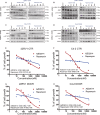Potent antitumour of the mTORC1/2 dual inhibitor AZD2014 in docetaxel-sensitive and docetaxel-resistant castration-resistant prostate cancer cells
- PMID: 33507584
- PMCID: PMC7933970
- DOI: 10.1111/jcmm.16155
Potent antitumour of the mTORC1/2 dual inhibitor AZD2014 in docetaxel-sensitive and docetaxel-resistant castration-resistant prostate cancer cells
Abstract
Recent studies indicate mammalian target of rapamycin (mTOR) may play an important role in PCa progression and drug resistance. Here, we investigated the effects of a novel mTORC1/C2 dual inhibitor, AZD2014, on naive and docetaxel (Doc)-pre-treated castration-resistant PCa (CRPC) cells and explored its therapeutic potential in CRPCs. In the current study, AZD2014 has a greater inhibitory effect against 4EBP1 and AKT phosphorylation than rapamycin in CRPC cells and prevented the feedback activation of AKT signalling. Importantly, AZD2014 suppressed CRPC cell growth in vitro by suppressing proliferation, apoptosis, cell cycle arrest at G1 phase and autophagy to a greater extent than rapamycin. Moreover, AZD2014 was more efficacious than rapamycin in inhibiting migration, invasion and EMT progression in Doc-sensitive and Doc-resistant CRPC cells. Overall, AZD2014 showed significant antitumour effects. Thereby, the current study highlights a reliable theoretical basis for the clinical application of AZD2014 in both Doc-sensitive and Doc-resistant CRPCs.
Keywords: AZD2014; antitumour; castration-resistant prostate cancer; docetaxel; mTORC1 and 2.
© 2021 The Authors. Journal of Cellular and Molecular Medicine published by Foundation for Cellular and Molecular Medicine and John Wiley & Sons Ltd.
Conflict of interest statement
The authors declare that they have no competing financial interest.
Figures






Similar articles
-
Dual mTORC1/2 inhibitor AZD2014 diminishes myeloid-derived suppressor cells accumulation in ovarian cancer and delays tumor growth.Cancer Lett. 2021 Dec 28;523:72-81. doi: 10.1016/j.canlet.2021.09.017. Epub 2021 Sep 21. Cancer Lett. 2021. PMID: 34560229
-
mTORC1/2 Inhibitor Served as a More Ideal Agent Against the Growth of Mouse Lymphocytic Leukemia Both In Vitro and In Vivo.Anticancer Res. 2019 Sep;39(9):4829-4835. doi: 10.21873/anticanres.13668. Anticancer Res. 2019. PMID: 31519585
-
The mTORC1 inhibitor rapamycin and the mTORC1/2 inhibitor AZD2014 impair the consolidation and persistence of contextual fear memory.Psychopharmacology (Berl). 2020 Sep;237(9):2795-2808. doi: 10.1007/s00213-020-05573-1. Epub 2020 Jun 29. Psychopharmacology (Berl). 2020. PMID: 32601986
-
Exploitation of the Androgen Receptor to Overcome Taxane Resistance in Advanced Prostate Cancer.Adv Cancer Res. 2015;127:123-58. doi: 10.1016/bs.acr.2015.03.001. Epub 2015 Mar 29. Adv Cancer Res. 2015. PMID: 26093899 Review.
-
Discrete signaling mechanisms of mTORC1 and mTORC2: Connected yet apart in cellular and molecular aspects.Adv Biol Regul. 2017 May;64:39-48. doi: 10.1016/j.jbior.2016.12.001. Epub 2017 Jan 4. Adv Biol Regul. 2017. PMID: 28189457 Review.
Cited by
-
Cell Plasticity and Prostate Cancer: The Role of Epithelial-Mesenchymal Transition in Tumor Progression, Invasion, Metastasis and Cancer Therapy Resistance.Cancers (Basel). 2021 Jun 4;13(11):2795. doi: 10.3390/cancers13112795. Cancers (Basel). 2021. PMID: 34199763 Free PMC article. Review.
-
The Molecular Biology of Prostate Cancer Stem Cells: From the Past to the Future.Int J Mol Sci. 2023 Apr 19;24(8):7482. doi: 10.3390/ijms24087482. Int J Mol Sci. 2023. PMID: 37108647 Free PMC article. Review.
-
Kinase-independent role of mTOR and on-/off-target effects of an mTOR kinase inhibitor.Leukemia. 2023 Oct;37(10):2073-2081. doi: 10.1038/s41375-023-01987-w. Epub 2023 Aug 2. Leukemia. 2023. PMID: 37532788
-
SCYL1-mediated regulation of the mTORC1 signaling pathway inhibits autophagy and promotes gastric cancer metastasis.J Cancer Res Clin Oncol. 2024 Oct 12;150(10):456. doi: 10.1007/s00432-024-05938-5. J Cancer Res Clin Oncol. 2024. PMID: 39394539 Free PMC article.
-
Role of PI3K-AKT-mTOR Pathway as a Pro-Survival Signaling and Resistance-Mediating Mechanism to Therapy of Prostate Cancer.Int J Mol Sci. 2021 Oct 14;22(20):11088. doi: 10.3390/ijms222011088. Int J Mol Sci. 2021. PMID: 34681745 Free PMC article. Review.
References
-
- Siegel RL, Miller KD, Jemal A. Cancer statistics, 2019. CA: A Cancer J Clin. 2019;69:7–34. - PubMed
-
- Chen W, Zheng R, Baade PD, Zhang S, Zeng H, Bray F, et al. Cancer statistics in China, 2015. CA: A Cancer J Clin. 2016;66:115–132. - PubMed
-
- Damber JE. Endocrine therapy for prostate cancer. Acta Oncologica (Stockholm, Sweden). 2005;44:605‐609. - PubMed
-
- Lowrance WT, Murad MH, Oh WK, Jarrard DF, Resnick MJ, Cookson MS. Castration‐resistant prostate cancer: AUA guideline amendment 2018. J Urol. 2018;200:1264–1272. - PubMed
-
- Cornford P, Bellmunt J, Bolla M, et al. EAU‐ESTRO‐SIOG Guidelines on Prostate Cancer. Part II: treatment of relapsing, metastatic, and castration‐resistant prostate cancer. Eur Urol. 2017;71:630‐642. - PubMed
Publication types
MeSH terms
Substances
Grants and funding
LinkOut - more resources
Full Text Sources
Other Literature Sources
Miscellaneous

